The Ultimate Guide to Declutter Toys: The Meltdown-Free Method You Need to Try Now
In this post: Want to declutter toys in your child’s bedroom or playroom? Here’s what you need to know about how to declutter kids’ toys.
My 7-year-old son had become wise to my ways.
I was sorting through his toys, looking for items to put in an upcoming consignment sale. It’s how I’d funded much of his wardrobe and updated toy collection each year … get rid of the old, bring in the “new.”
Except this year, he was putting his foot down.
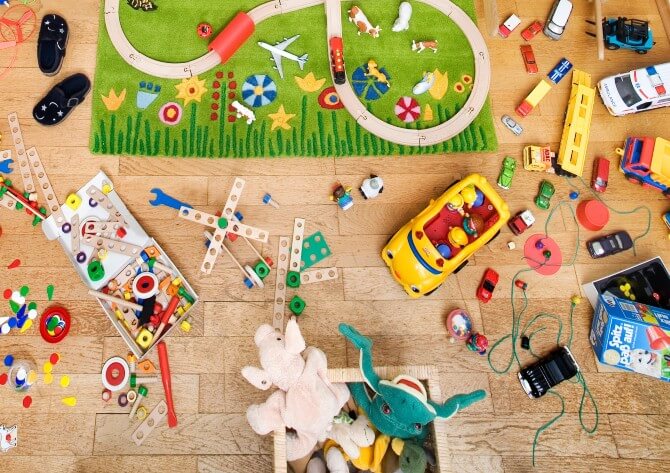
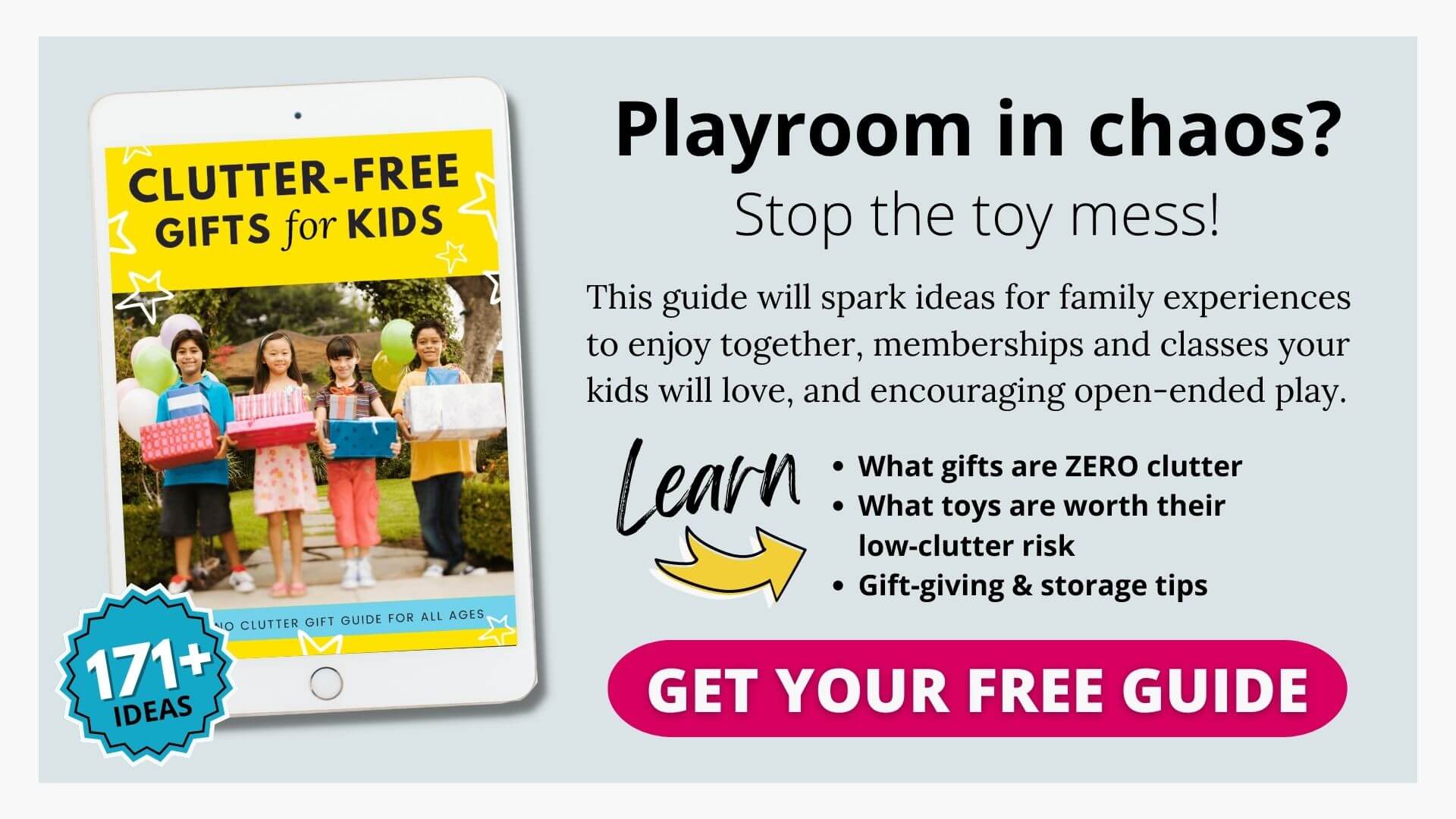
“No! Mom! Don’t sell that,” he said, while clutching a precious broken McDonald’s Happy Meal toy to his chest. (Or insert here any-toy-he-hasn’t-played-with-in-almost-a-year-but-suddenly-loves-because-he-knows-I’m-cleaning-out-the-toy-box.)
I don’t want to upset him or have him think all his things just disappear suddenly when I get tired of them. But, at the same time, we only have so much storage space, so we do need to make a cull and declutter toys every now and then.
Yet, if he really, TRULY loves it, it stays.
His toys, his say, for the most part.
(That being said, he knows that fast-food kids’ meal toys are “for now” toys and not “forever toys.” That’s our rule.)
So how do you reduce the toy-grabbing and actually clear out the playroom or bedroom toy chest every once in a while?
Do you want to declutter toys but it just feels daunting?
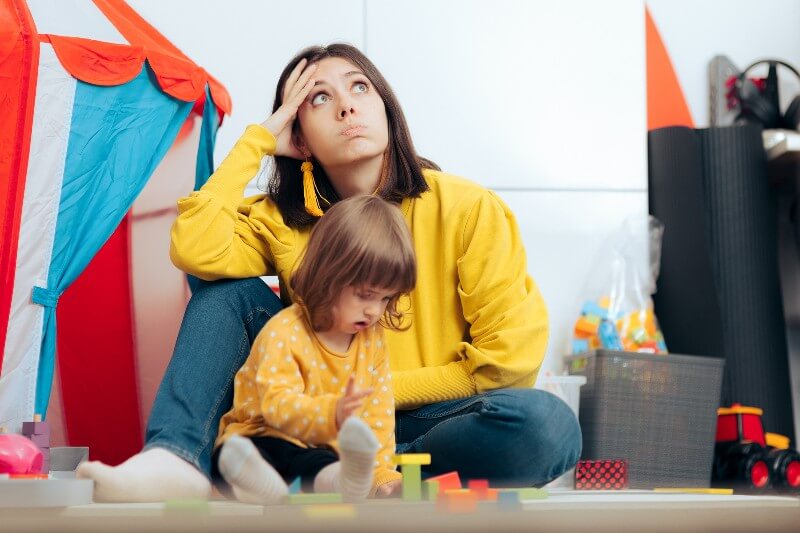
May contain affiliate links to items for which I receive a small commission at no extra cost to you, if you click through and take action on an offer. As an Amazon associate, I earn from qualifying purchases.
What’s worked for us in the past few years has been: choices.
Very clear choices.
Is this a toy that you want in your room? Or can we put it in this tub to save for later?
Is this a stuffed animal that is special to you? Or can we let it go to another kid who needs a stuffed animal?
Do you still play with this? Or can we sell it so you have some money to spend?
Now, don’t get me wrong. My kiddo clings tightly to many of his things. And sometimes? It drives me nuts! But, I need to show him the same respect I want him to show to others (and their things). Especially now that he is old enough to express his strong opinions about his belongings when we declutter toys.
This means sometimes that darn McDonald’s toy stays.
And sometimes? Sometimes he surprises me by making unexpected and confident choices like saying goodbye to a toy I thought he enjoyed but he’s decided to let go.
If you find yourself in a similar position with your kids, keep reading for more suggestions to help with the toy struggle.
Why you should declutter toys
First things first, why should you take the time to declutter toys at all?
Because kids thrive in less cluttered environments. And so do parents (imagine being less stressed about company coming over, because everything easily stores away with a quick tidying session!).
Emotional, Psychological, and Physical Wellbeing
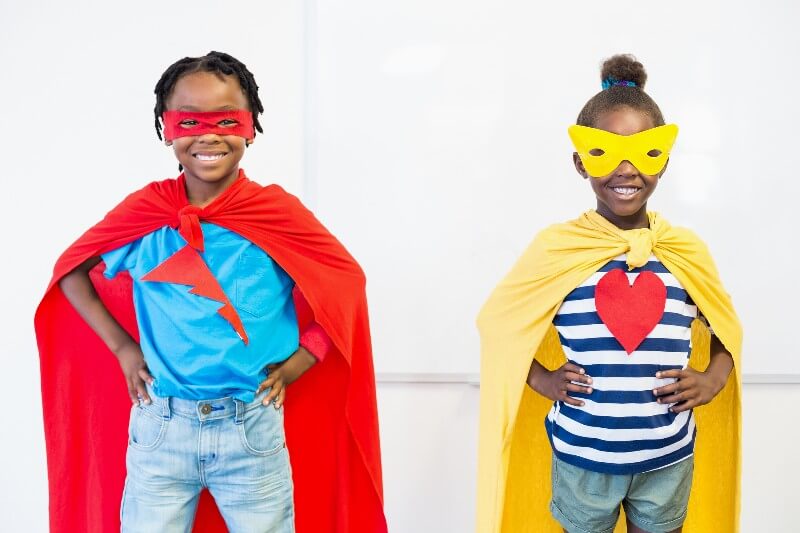
Clutter impacts your child’s emotional health and development. Studies show that living in a chaotic, cluttered environment not only stresses out women, but also can negatively impact children’s cognitive development, academics, behavior, and socio-emotional functioning.
Clutter impacts your child’s physical health, as well. Clutter gathers dust and mold, under the right conditions. This can cause respiratory and other health problems. Pests hide under piles and in dark crevices, leading to infestation and leaving behind waste that is toxic to humans.
In the case of highly cluttered homes, other safety concerns are present. Too many items on the floor, or blocking quick exits in case of emergency, are tripping or fire hazards.
None of these situations are good for kids.
Clutter literally impairs our ability as humans to live well in our home environment, and that is no different for children. Let that sink in for a moment.
Time savings
If you’re spending all your time either being irritated at cleaning up piles your kids have created, or fussing at them to clean it up themselves, it’s time for a change.
Some ways that decluttering toys will help save you time include less cleaning and moving around piles, less procrastination on your kids’ part in putting toys away, less fussing at your family to clean up, and less sorting the next time you embark on a toy decluttering session. (Hallelujah!)
Ease of clean-up
When kids aren’t overwhelmed (heck, when WE aren’t overwhelmed!) clean up is a breeze. It’s a lot easier to ask a child to pick up 10 toys and put them in their designated homes than it is to scowl at a floor totally covered in stuff and demand it be spotless by the time you come back.
If there is an actual home for something, they can put it there without getting lost, confused, or overly frustrated. (Well, at the cleaning, that is. I can’t promise they won’t be frustrated by the request to clean.)
How to declutter children’s toys
1. Sort and categorize the toys
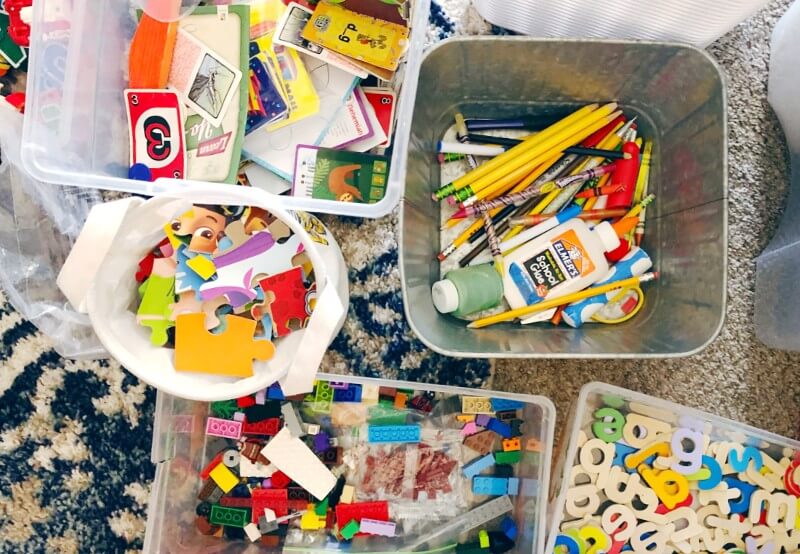
Gather all the toys up into one spot and inspect them, or go systematically from one storage spot or toy category to the next. Don’t worry too much about what you’ll decide to do with them yet.
Put like with like—dolls with dolls, building toys with building toys, vehicles with vehicles, and so on. You might be surprised how the piles will g-r-o-w as you sort!
It helps to have some boxes or bins of different sizes on hand in which to easily put the items you’ve sorted, like I did in the image above when working on a client’s playroom.
Now you’re ready for the next step.
2. Edit and purge the toys
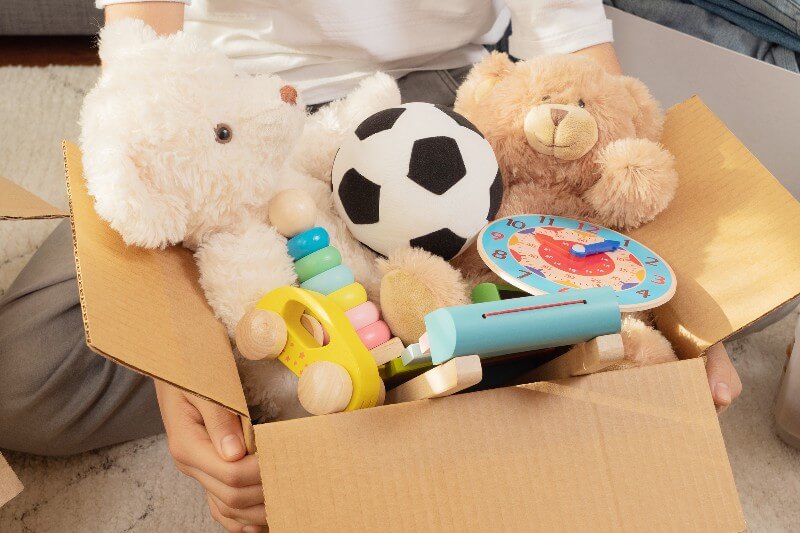
Next, go through each category you’ve sorted. Toss broken and worn out toys as you come across them (unless they’re keepsakes). Ask yourself these questions as you declutter toys:
- Is this broken or worn out?
- Has my child outgrown it?
- Does my child use this frequently … or do they ignore it?
- Do we have more than one of these?
- Is this a keepsake?
Note the most loved and least loved on the shelf or in the toy box.
Set aside any unused toys in good condition that could be donated or sold at a consignment sale.
If you notice a beloved toy being set aside for newer and more interesting items, and you want to keep it, put it in a lidded storage tub that will serve as the “memory box” for the early years.
If an item isn’t especially sentimental, set it aside in a box or bin out of sight for a few weeks (or months) to see if your child asks for it again. If not, feel confident donating or selling those items to make room for the next stage of development.
For the very young, in the preschool years and younger, this step alone might be all you need to do to keep on top of the ever-growing pile of toys that pile up through the various early stages. For older kids, however, you may want to start a toy rotation. (More on that next.)
3. Set aside some toys for a toy rotation, if desired
For older kids, tucking away old favorites in a memory box and immediately selling or donating the rest of your child’s outgrown toys and items may backfire and turn into resentment or possessive behavior if you don’t involve them in the process at least a little.
I believe we should model respect for our kids when we declutter toys, even in these early years, while maintaining healthy boundaries (for both our relationships and their stuff.)
It’s important to not create anxiety for our kids about their stuff just suddenly disappearing.
So, you may want to start a toy rotation and only leave out their 5-10 favorite toys each (sets of play items like blocks or figurines count as 1 toy in this case), and put the rest in 1-3 other bins to rotate out every few weeks. Let your children pick those 5-10 favorites you set aside for regular play.
If unchosen toys still are neglected after reappearing a couple of times in the fresh rotation, either donate/sell automatically or request your kids to fill a container of the size of your choice to put a natural limit on decision-making.
Tell them to put their “must keep” toys in there and then help you decide what to sell or donate from what remains.
Ask your child which items can be given to other kids and have them select toys from their stash to put in a donate box. They might surprise you.
After a few months of toy rotation like this, you should have naturally pared down on the amount of clutter in your kids’ bedrooms or playroom.
The end goal is always to have a space that is easy to pick up and keeps organization simplified so your kids can participate in the process, or even take full ownership of maintaining a clean room, depending on their age and maturity level.
And a bonus is that having fewer toys actually encourages kids to focus and engage in more creative play!
So how can we organize their spaces in a way that will make this possible?
4. Create zones in the play area
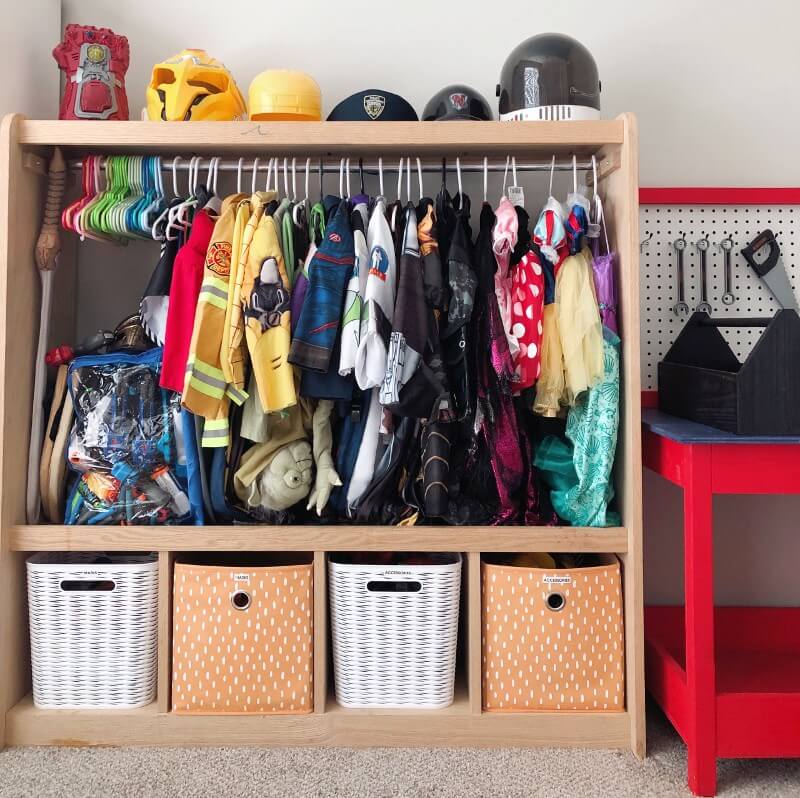
The easiest way to put something back in its place is to make sure nothing else is already occupying that place. When you create a zone for different types of toys and play in your child’s bedroom or playroom, you create homes for things. Those homes, in turn, simplify clean up.
The zones you have will be determined by your family and living spaces, but here are some ideas to get you started:
- Pretend play
- Building sets
- Vehicles
- Books
- Action figures / dolls
- Zoo animals
- Farm animals
- Stuffed animals
- Puzzles
- Games
- Kitchen
- Outdoor toys
- Play weapons
- Arts & Craft
- Dress up
- Tools
- Potato Heads
- LEGO bricks / DUPLO bricks
- Musical instruments
This is by no means an exhaustive list, but you get the idea!
5. Organize the toys
K.I.S.S. — Yup. I’m talking about Keep It Simple, Sweetheart. (I’m not about name-calling around here, lol.)
Your kid spaces should be designed in a way that makes it easy for them to obey you when you say, “time to clean up.”
Only storing their top 5-10 favorite toys in their play area will help tremendously, but if they have to put everything in a particular spot in a particular way (especially if it requires more dexterity or fine motor control than they currently possess), it’s setting them up for failure.
Lower your expectations to their ability level.
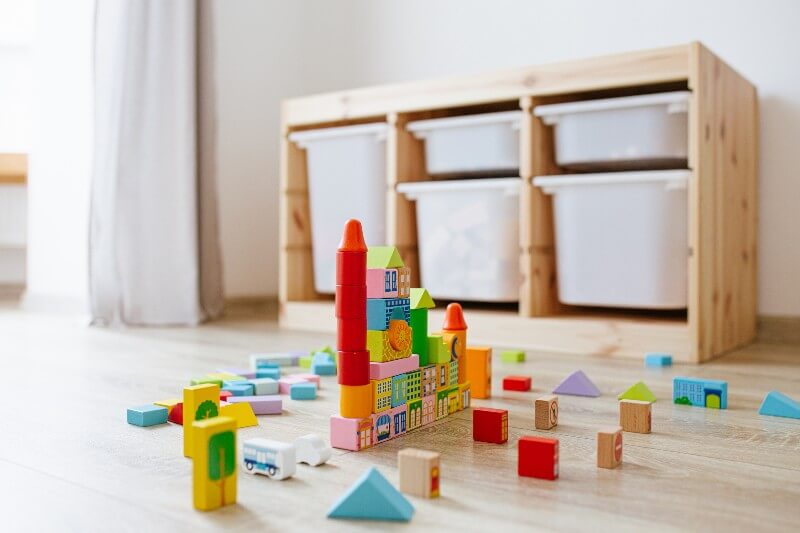
TODDLERS AND PRESCHOOLERS. For the youngest kids, take cues from preschool and Montessori classrooms and keep storage low to the ground and accessible to them to foster independence.
Use sturdy open shelving at their level, and heavily utilize open baskets or bins for dumping blocks or Duplos or cars. Even a two-year-old can help clean up if all they have to do is dump their dolly on a shelf and be done.
When my son was this age, I went on Facebook Marketplace and found a used sturdy wooden bookcase with rounded corners that was being sold by a preschool that was making room for new furniture.
If it doesn’t fit on that shelving, or in a large open bin on the floor, don’t keep it out.
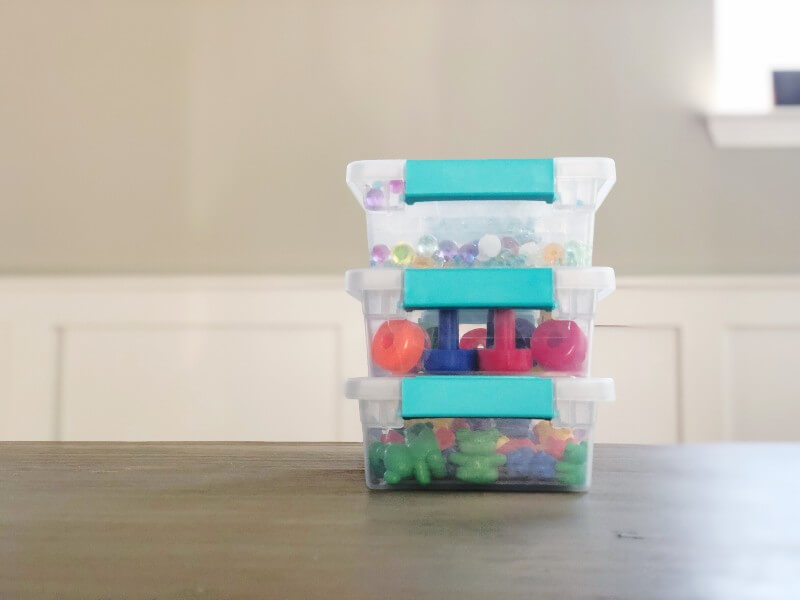
GRADES K-2. For this age group of children, add cubbies or toy boxes, lidded bins, and labels
Again, embracing a K.I.S.S. mindset (I really need to come up with a better term for that. I’ll let you know if I do!), dump-and-go is best for this age group.
BUT if you can allocate what gets dumped where, you’ll be much happier with the result.
With a 9-square cubby, you can add open-top fabric bins, clear plastic (lidded) bins, and zippered bags.
It doesn’t have to be pretty to be functional, but if you can find bins that appeal to your aesthetic and are easy for your child to open and close on their own, that’s a win-win!
For kids who aren’t yet reading, you can take a picture of the type of toy that goes in the bin, print it out and laminate it, then attach it to the bin (Velcro tape or a simple zip-tie through a handle will do that job nicely).
For kids who can read, print out labels for shelves, drawers, bins, or clear plastic containers.
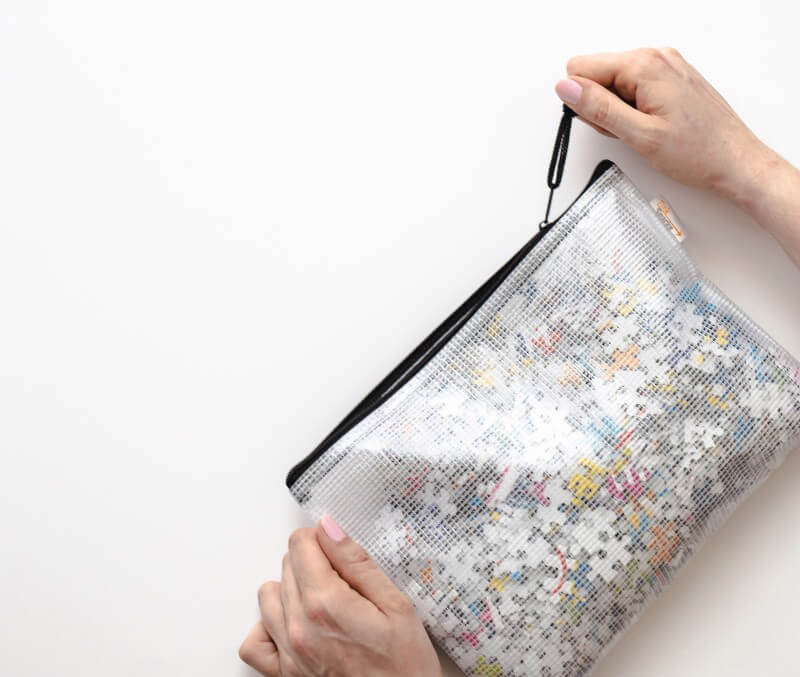
OLDER KIDS AND PRETEENS. Introduce hidden storage and more specific sorting categories
As kids gain dexterity and confidence, you can add some sophistication to the organization.
For instance, older kids who play more board games or enjoy puzzles might be able to use sturdy zippered pouches to store them upright in a bin or basket.
Stacking bins with dividers and lids, baskets, and cabinets are ideal for this age group.
6. Make it EASY for kids to clean up
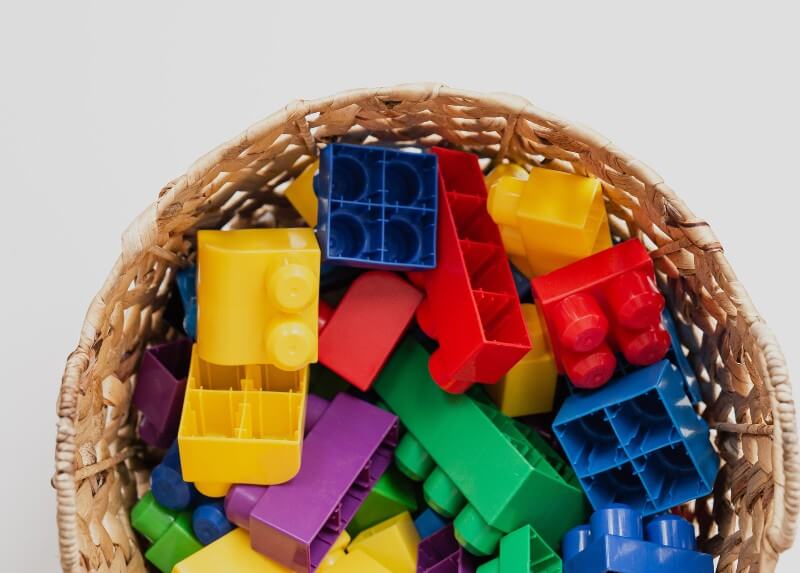
Y’all. I see it alllll the time … the adorable playrooms, the boho bedrooms, the picture perfect nurseries with nary a diaper wipe in sight …. it looks great on Instagram, but is it sustainable in person?
Because when a blow-out happens, you need those wipes STAT. With all due respect to the amazing Marie Kondo, keeping useful items out of sight between uses simply means you’ll have one hand on a baby, one hand in a cabinet or drawer you care barely open single-handedly, and a kid who desperately needs to be cleaned up.
And it’s even more alluring to focus on form over function as kids get older and their toys start looking, well, garish.
The thing is, if dump-and-go in a giant bin even though all the things are a mish-mash means the room actually gets cleaned by your kids … then that, my friend, is the method that you need to embrace.
Asking for more steps than they can handle or have patience for (carefully labeled boxes for each ultra-specific type of plaything, color separated legos, books lined up by subject, etc.) will ultimately just be frustrating for everyone.
Make it EASY for them to clean up. Don’t impose complicated systems. Open buckets, clear plastic bins with clip-handle lids. Shelves. And if the chaos of all the colors and stuffed bins drives YOU nuts, try to have all the bins behind cabinet doors. Close the doors, and voila! Instant calm.
How to overcome your kids’ decluttering objections
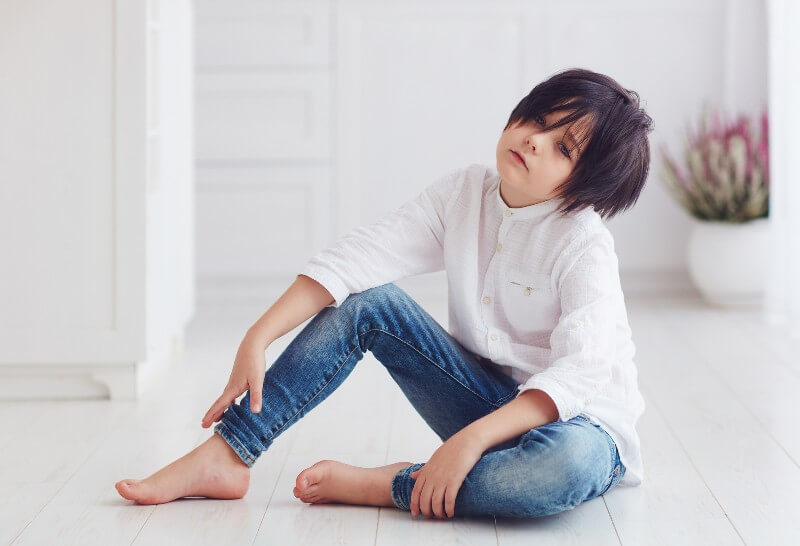
Offer to pay your kids
If you sell toys at consignment or yard sales or Facebook Marketplace, let your kids keep part of the money. This not only teaches entrepreneurial skills but also incentivizes letting go of outgrown toys, especially if it means they can buy something new they’ve been wanting as a result.
Set a number limit
Ask your child to select his/her top 10-20 favorite toys to keep in their bedroom or the playroom. Move everything else to accessible hidden storage like drawers in a closet or plastic totes.
Set a container size limit
Pick a shelf, box, bin, or other storage “container” and allow your child to pick their favorite toys to fill that container. Whatever fits, stays in the room. Whatever doesn’t will go in storage for later (or the toy rotation), or will be donated.
Create a “memory box”
If your kids (or you!) can’t bear to part with a treasured toy from an earlier stage of their development, simply keep it in a designated storage bin as a keepsake to be stored for them for years to come. Not just everything can be a keepsake, though. It will still need to fit the confines of your container size limit here, as well.
Celebrate milestones
Has your toddler graduated to a big girl room? Or your big kid has become obsessed with Star Wars, like mine has? Has your preteen officially entered their teenage years? Take that opportunity to update their room decor, storage areas, and style. Let them help you pick out new bedding or wall decor and gently guide them to let go of items that no longer suit the room or their age group.
How to keep toys decluttered
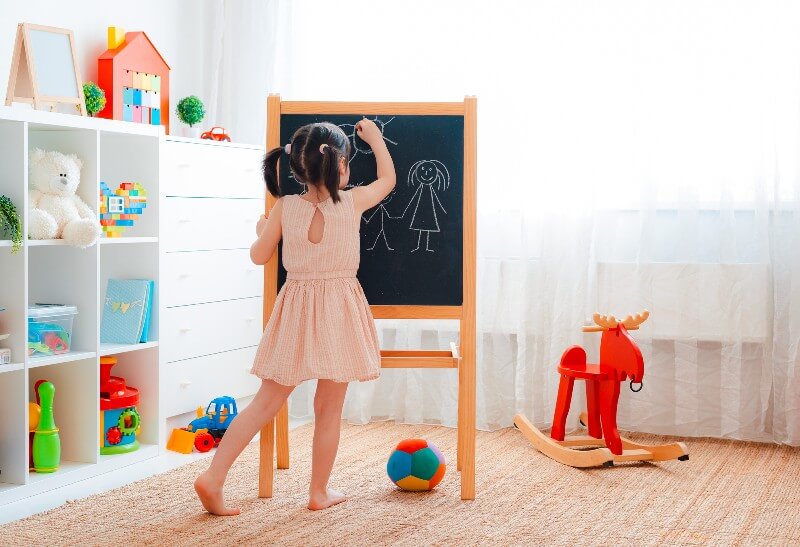
Try a toy rotation
Instead of asking your kids to get rid of toys, explain you are only leaving out their favorites for now, and the extras will be put aside. Use clear totes to store the other toys, and then pull them out in a few weeks or months and voila! New toys to love. (Then, put aside the ones they’d been using during that time, in return.)
Set toy rules
With rules in place, your kids know to expect that everyday toys (obviously not well-cherished ones!) that are broken beyond repair or worn out or used up in some way will be tossed.
This way, puzzles missing pieces, those pesky McDonald’s toys that take over, broken train tracks, Barbies with no limbs or clothes, and scribbled over coloring books can be weeded out with fewer tears.
This also could mean creating a rule like ours that fast food kids’ meal toys are “for now” only. Or perhaps instituting an annual pre-birthday and pre-holiday mini-purge to make room for their fun new things.
Holidays and birthdays, especially, makes toy bins overflow and carpets your floors with an explosion of colors and textures. In our house, party favors and fast food meal toys are “for now” toys and not “forever” toys.
Our son knows that unless they are an item from a favorite franchise (Star Wars, for instance), he’s not going to keep them past the meal or a few days after the party.
Avoid toy overload
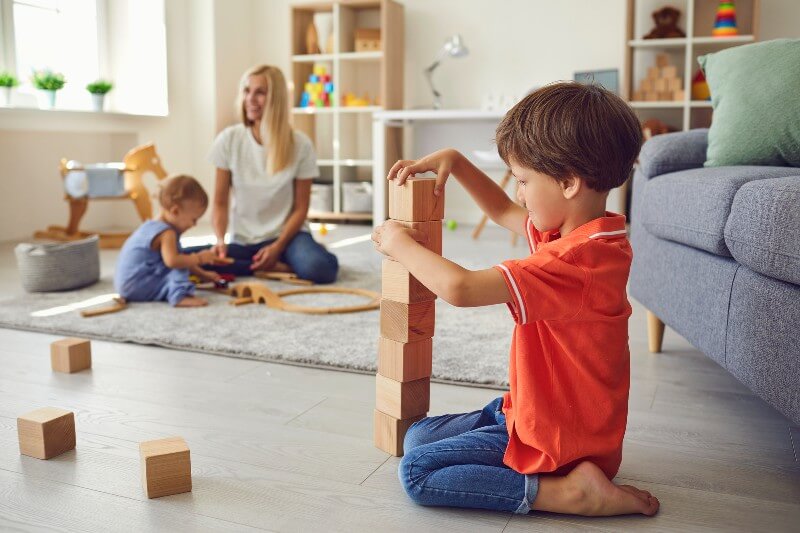
- Limit the number of toys you personally buy your kids (or Santa brings them!), so when others give them items, it is less overwhelming.
- Let friends and family know if your kids love experiences or consumable gifts, like a museum membership or art supplies.
- When people ask for your kids’ wishlists, make sure they include open-ended play toys that can be used for many purposes (like blocks or foam shapes).
- Occasionally go through the toys your kids pull out just to get to their favorites, and weed out the toys they consistently ignore or outgrow. This is easiest to do by yourself with younger kids, but once your kids feel ownership of things, set limits on storage and let them pick what to keep and what to put in the toy rotation storage or what to sell/donate.
You decluttered your kids’ toys. What’s next?
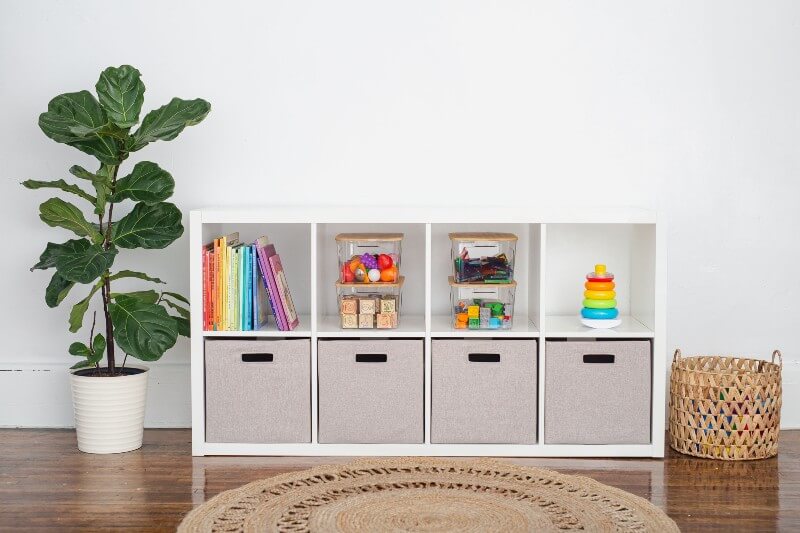
Buy furniture that doubles as storage space
If it can accommodate a box or basket for easy access to necessities, even better! (I keep dog grooming brushes in a basket on my coffee table, for instance.)
Cubby shelves are ideal for younger kids’ rooms and playrooms, of course. But you don’t have to stop there! Think of storage ottomans for quick clean up of toys in a living room, buffet tables filled with art supplies instead of dishes and silverware, and bookshelves with bins and baskets.
Restrict your younger kids’ access to small pieces
This includes board games or any other toys with lots of small pieces (hello, Monopoly), building sets, puzzles, etc.
This way you don’t discover the family room covered in mixed-up pieces of who-knows-what and have to undo the chaos.
Buy toys that are easy to clean up
Usually these are open-ended play items or things that help them get their wiggles out with gross motor skills. Think play tunnels, wobble boards, foam shapes, blocks, and costumes. Things that can either be immediately stored in a tub or on a shelf and you’re done. Or, play sets / building sets that can be placed in a bin, basket, or clear tub.
AIM FOR EVERYTHING IN THE ROOM TO BE ABLE TO BE PUT AWAY IN 10 MINUTES OR LESS.
FAQ
What if I don’t have room for all the toys in the playroom/bedroom?
The best way to get around that, I’ve found, is to allow a certain container, whether it is a cubby shelf, plastic tub, or drawer, for your child to fill with whatever they want. Explain that everything else must be removed from the room.
If they are willing, pass the remaining toys on to other kids, donate them, or even sell them (but that tends to stall your progress, so I recommend avoiding that for now).
What if my kid won’t give up any toys?
If they insist everything is special to them and resist all your attempts to declutter toys, that’s when a toy rotation will come into play. Gently tell them that these toys will be set aside for later, and then switch out the toys every so often … but never more than can easily be cleaned up by your child(ren).
You could also try a “maybe” or “decide later” box and give the separation a trial run. Let your kids know anything put in that box will be saved to decide on later, but removed from the play area to make it easier to clean up.
How do I tell people my kids already have too many toys?
You can, if asked what your kids are into these days, tell them about the activities your kids like, instead of specific toys. Mention favorite places to visit, like the zoo, children’s museum, or bounce house location.
If your kids are into Roblox or Minecraft, tell the gift giver where they can purchase digital or physical gift cards for buying items in the game. (My own little gamer LOVES Roblox gift cards.)
Tell them about characters or things your kids love and suggest they need new bedding or pajamas or something else useful so they can thrill your child as desired, but also not add unnecessary loud plastic toys.
You can even tell them you regularly declutter toys and talk about how things have improved in your home since doing so.
If they STILL insist on buying toys, accept them graciously. The thought was the gift, and the giver’s relationship with you and your child is important.
However, ultimately, what you do with a gift after it is given is up to you and your child.
How do you declutter toys without guilt?
You can declutter toys without guilt by focusing first on only letting go of broken, worn-out, and un-played-with toys. Party favors, Easter basket items, fast food kids meal toys, and anything bought at a dollar store, yard sale, or consignment sale are also possible items to declutter without guilt.
If a toy is a gift, remember that your child is growing and getting older and changing interests all the time. The gift, at the time it was given, was what mattered. Keep the memory, and release the item when it is time.
Finally, avoid the guilt by including your older children in the process and setting clear space limitations on what they can keep out.
Take a first pass to find the broken and discarded non-favorites if you wish (I like to put these in a time out box out of sight until I’m sure my son doesn’t miss them at all), but then involve the kids for the next pass to respect their feelings on the topic of letting go to make room.
How do I get rid of a lot of toys?
The best way to get rid of a lot of toys is to first sort them into similar piles of items and then see where you have duplicates that can be reduced. Those duplicates don’t have to be identical (say, 15 different Barbie dolls instead of 3 identical cars).
Why is it so hard to get rid of toys?
Because toys are emotional items many times. They’re given by friends or family on special occasions, or they’re something you yourself purchased in hopes of bringing a big smile or excited squeal. It’s hard to distance yourself from that emotion.
Or, sometimes it’s just hard to let go of something you spent a lot of money on.
It’s also hard because kids naturally don’t want to let go. And sometimes, in that case, it’s only time that will help ease the difficulty. (Though Katie of Katie’s Kottage has a great tip to work around that.)
Other times, parents who grew up with very little when they were young want to ensure their kids don’t have the same experience.
But it pretty much all boils down to an emotional response.
Final thoughts on how to declutter toys
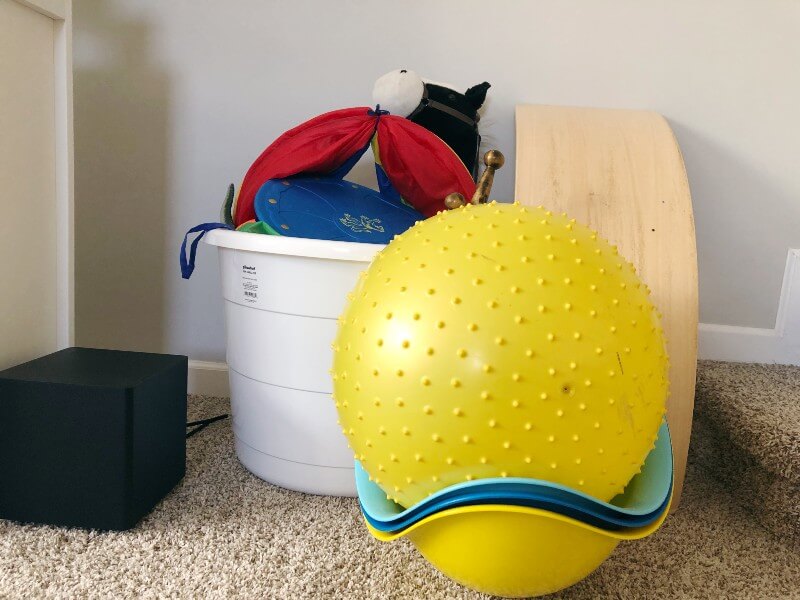
Two years after my son began clutching McDonald’s Happy Meal toys and calling them precious, he’s still insisting that all his toys are special to him. And I believe him.
As my son gets older, it’s less common for us to declutter toys now. For one thing, he’s down to just what he loves and uses frequently. But for another, he’s slowly outgrowing toys in general.
LEGO bricks and stuffed animals are his most commonly played with toys now, and our sole toy bin is mostly filled with pretend play dress up items and a few action figures, for times younger kids come and visit.
Otherwise, we’re now decluttering used up art supplies, discarded sketches, and neglected picture books.
That’s how it goes with kid stuff. Decluttering toys is a constantly shifting landscape that follows the ebbs and flows of childhood transitions. And one day, I’ll wake up and realize I’m decluttering these LEGO sets and my precocious 9-year-old is a grown up 19-year-old, off at college.
Slow down, time.
Want to keep toy clutter to a minimum in your house? Try this!
Are you in one of those transition phases of the toy decluttering process and trying to pare down to essentials for the sake of your sanity and your kids’ happiness, but having a hard time figuring out what to do for gifts during birthdays and holidays?
Then download this FREE Clutter-Free Gifts for Kids guide to get gift ideas that take up zero space in your home!

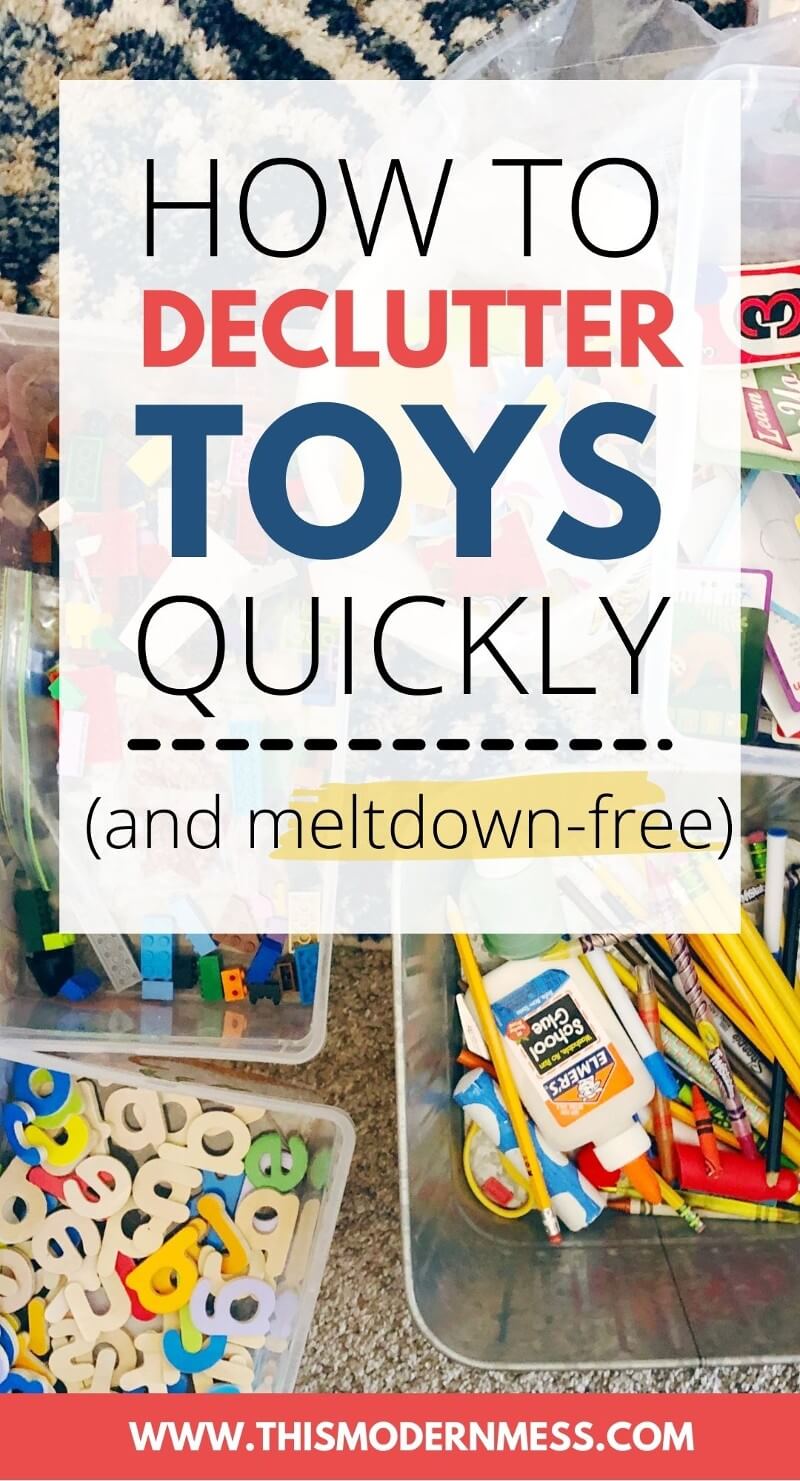

2 Comments